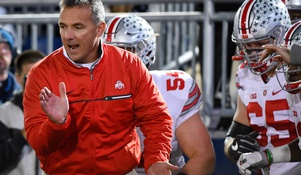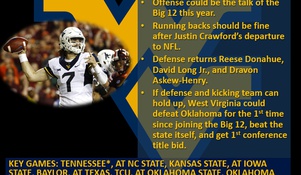WVU Football's identity change
Besides Alabama, it is hard to find a college football team hotter than West Virginia since Nov. 7, 2015.
On that first game of November, West Virginia defeated Texas Tech. This past Saturday, the Mountaineers defeated the Red Raiders.
In-between those wins over Texas Tech, West Virginia is 10-1.
By comparison, the Crimson Tide are 14-0 since Nov. 7, 2015, and have won a national championship. The Mountaineers won the Cactus Bowl. Slight difference.
However, for West Virginia to even enter the conversation as the hottest team in the past year, the Mountaineers had to undergo an identity change.
In 2014, the infamous Dana Holgorsen “air raid” was in its prime. With Clint Trickett under center for the majority of the season, wide receivers Kevin White (1,447 yards) and Mario Alford (945 yards) combined for 21 touchdowns and were the focal point of West Virginia’s offensive attack. The Mountaineers ended the year ninth in the country with an average of 317.0 passing yards per game.
The next year, the Mountaineers made a 180-degree turn.
A year after ranking 45th in the nation in rushing yards per game with an 182.8 average, West Virginia averaged 228.2 yards rushing and finished 16th in the country.
After rushing for 1,461 yards in the first seven games of the 2015 season, the Mountaineers had more yards rushing than they did passing four times in the final six games of the 2015 season.
In the following six games, West Virginia rushed for a combined 1,506 yards. After a pass-heavy start led to a 3-4 record, West Virginia’s switch to the run in the second half buoyed it to 5-1 finish.
In the 7-6 2014 season, the Mountaineers rushed for 2,376 over the entire season and no one picked up more than Rushel Shell’s 788 yards. In 2015, Wendell Smallwood led West Virginia and the Big 12 with 1,519 yards.
Of course, the run-dominant offense went away in the Cactus Bowl shootout.
Until the bowl game win over Arizona State, the Mountaineers rushed for no less than 166 yards since Nov. 7, 2015. Besides the 166-yard rushing showing in the 24-23 loss to Kansas State on Dec. 5, West Virginia rushed for at least 213 yards in all of its final four regular season wins.
On Jan. 3, the Mountaineers rushed for a solid 144 yards but busted out passing-wise to the tune of a season-high 532 yards. All five of West Virginia’s touchdowns came through the air.
Since then, West Virginia has not been as run-heavy but has developed a more balanced offensive attack.
The Mountaineers 216.2 rushing yards per game in 2016 are 30th in the nation and their 318 passing yards per game are 16th.
Part of why West Virginia has become more balanced is because Smallwood went to the NFL Draft following the 2015 season, leaving the Mountaineers with Shell as the only major contributing running back returning for 2016.
Despite that, West Virginia has rushed for at least 120 yards in all five games in 2016, thanks in part to Shell (348 yards) and junior college transfer Justin Crawford (373 yards).
However, the rise in the passing game cannot be understated. Though senior quarterback Skyler Howard is interception prone (Howard has thrown six interceptions in the past six games, dating back to the Cactus Bowl), he has looked more comfortable in 2016. After having only two games of more than 300 passing yards in 2015, Howard has thrown for at least 300 yards in three of five games this season.
A big reason for Howard’s improvement has come from the improved receiving corps around him. Daikiel Shorts failed to have a 100-yard game in 2015, but has two already in 2016. Ka'Raun White didn’t make a catch until the sixth game of 2015 but already has 23 receptions this season.
Because of the improved passing game, West Virginia’s total offense has improved. Its 534 yard per game average is seventh in the NCAA in 2016 only a year after finishing 23rd with a 480 yard per game average.
A week after throwing for 318 yards and rushing for 332 yards against Texas Tech, the No. 12 Mountaineers have reason to be excited about their offense. They’ll face TCU in Morgantown Saturday and the matchup plays favorably for West Virginia, since the Horned Frogs allow 424 yards per game, 84th in the nation.
For West Virginia to continue its best start to a season since also going 5-0 to begin 2012, its offensive production must continue. The Mountaineers will not score 39.5 points per game like they did that season under Geno Smith, but under a defense that limited the Red Raiders to 17 points, West Virginia doesn’t have to run a full-time “Air Raid” offense.





